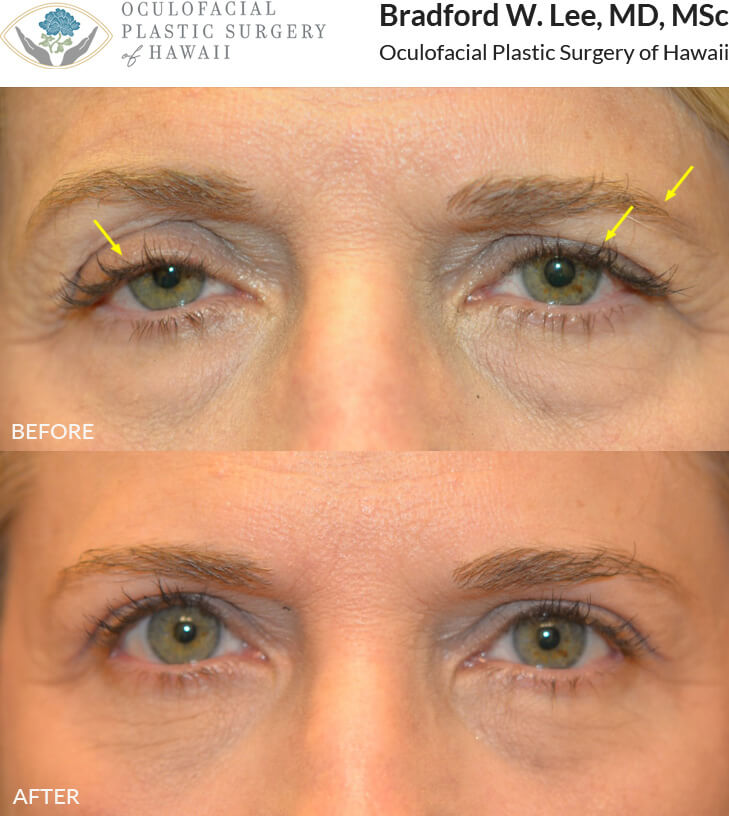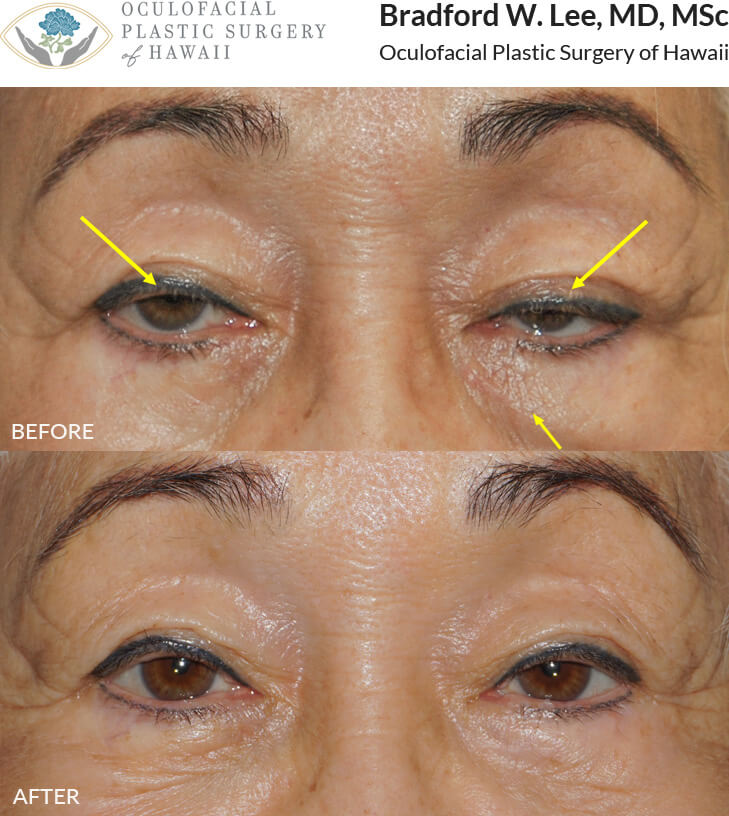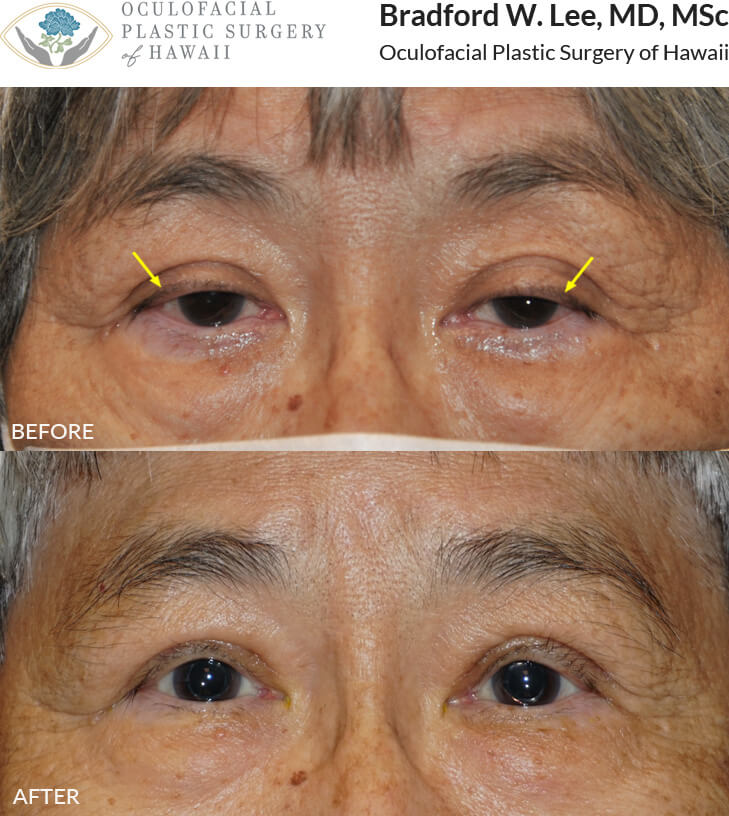Ptosis Surgery
What is Ptosis?
Eyelid ptosis is caused by weakness of the muscle that lifts the upper eyelid (the levator muscle). Eyelid ptosis causes the eyes to look small, half-closed, or sleepy. If ptosis is present on one side but not the other, one eye may look smaller than the other. The normal upper eyelid position should be over 2 mm above the pupil. If there is not over 2 mm of clearance, this is defined as ptosis. When ptosis is severe, it may block a patient’s peripheral vision and limit the amount of light that enters the eye.
What is Ptosis Surgery?
Ptosis surgery aims to tighten the levator muscle so that it lifts the upper eyelid better. This helps open the patients eyes so that they are larger, brighter, and have better peripheral vision. In most cases, the goal will be to position the upper lid with more vertical clearance above the pupil, somewhere between 2.5 mm and 4.5 mm.

This 57-year-old patient presented with asymmetric ptosis of the upper eyelids that made her look tired and with one eye bigger than the other. She was also bothered by drooping of the left brow that made her brows look asymmetric. The patient underwent a bilateral upper lid ptosis repair and blepharoplasty, as well as a left brow ptosis repair to improve her eyebrow symmetry.

This 72-year-old lady presented with droopy upper eyelids and excess puffiness on the left lower eyelid. The patient underwent a conservative upper lid ptosis repair to open her eyes, and a left lower lid skin-pinch blepharoplasty with dermal filler injection to the left tear trough region to improve her lower lid symmetry.
What are the Different Types of Ptosis Surgery?
Standard Ptosis Surgeries
Internal Ptosis Surgery: This is an excellent option for patients with mild ptosis, younger patients, and patients who have never had prior ptosis surgery. The levator muscle can be tightened through a hidden incision underneath the upper eyelid, so no skin incisions are required. The surgery is quick and gives an excellent cosmetic result.
External Ptosis Repair: This is a good option for patients who have had prior ptosis repair surgery, who have severe ptosis, or who have had prior glaucoma surgery. The levator muscle is tightened through an upper eyelid crease incision. The surgery takes slightly longer but can also have an excellent cosmetic result.
Ptosis Repair Surgery for Specialized Conditions:
Frontalis Sling: This surgery is an option for patients whose levator muscle does not function normally. Patients may be born with eyelid ptosis (i.e.congenital ptosis), have a muscular dystrophy, or have other rare causes of ptosis like myesthenia gravis, cranial nerve palsy, or other disorders. In this surgery, silicone bands are implanted through tiny incisions above the brow and an eyelid crease incision. The silicone band attaches the eyelid to the eyebrow, and patients use their eyebrow and forehead muscles to lift the eyelid.
Frontalis muscle advancement flap: this surgery is an advanced technique that is an alternative to a Frontalis Sling. In this surgery, Dr. Lee attaches the muscle that lifts the brows directly to the eyelid without the use of silicone bands. It gives an excellent eyelid contour and avoids the issues of implant infection, breakage or weakening of silicone bands. It is performed through an eyelid crease incision and avoids making tiny incisions above the brow.

Testimonials




What is the difference between Ptosis Surgery, Upper Blepharoplasty, and a Brow Lift?
All 3 of these procedures are sometimes called “eyelid lifts” but they are all completely different surgeries.
Ptosis repair surgery aims to open the eye and have a greater aperture between the upper and lower eyelids.
Upper blepharoplasty aims to remove excess skin and fat on the upper eyelid. In Asian patients, an additional goal may be to define, create, or give better symmetry to the eyelid fold.
A Brow Lift aims to lift the position of the brows when they become droopy and descend due to age and gravity.
Very often, these 3 procedures are performed in combination at the same time. However, not everyone needs all 3 procedures, and each can be performed separately.
This 80-year-old lady presented with asymmetric ptosis of the upper eyelids and upper eyelid crease asymmetry that made her appear tired and sleepy. She underwent a bilateral upper lid ptosis repair resulting in brightening of her eyes and improvement in her peripheral vision.
How does Dr. Lee customize ptosis repair surgery for his patients?
The process starts with a complete evaluation to examine your eyelids and eyes. Dr. Lee will review any prior eyelid, facial, or eye surgeries and also evaluate you for dry eyes. This will help determine the ideal ptosis repair technique to help you achieve your best result. He will discuss how much to open your eyes based on your individual preferences, what is safe for your vision, and what would look natural for you.
Some patients are interested in combining ptosis surgery with other procedures that will either improve peripheral vision or provide cosmetic improvement. Common procedures performed in combination with ptosis surgery include upper blepharoplasty, lower blepharoplasty, and brow lift.
Why do patients prefer an oculofacial plastic surgeon for Ptosis Surgery?
Oculofacial plastic surgeons have the greatest expertise around the eyelids and perform a wide variety of cosmetic and reconstructive eyelid surgeries. They can perform multiple eyelid and facial procedures at the same time to give patients their best results. They can correct challenging blepharoplasty complications referred by other surgeons, but more importantly, they can avoid complications in the first place through experience, training, and careful understanding of the delicate anatomy around the eyes.
In addition to being plastic surgeons of the eyelids and face, they are dually-trained as ophthalmologists. Thus, they understand how to customize eyelid surgery for patients with conditions like dry eye, corneal diseases, or who have undergone complex ocular surgeries. The eyelids protect the eyes and play an important role in preserving vision. Understanding the eyes and eyelids allows Dr. Lee to perform surgery safely and more conservatively when needed. This allows him to enhance the beauty of the eyes and eyelids while protecting patients’ eyes and vision.
Does insurance cover Ptosis Surgery?
Insurances will cover ptosis surgery on visual grounds in more severe cases where the eyelid is within 2 mm of the pupil. Insurance companies require photos, eyelid measurements, and visual field testing to see how much the eyelids are impairing vision. If there is mild ptosis that is causing asymmetry but does not meet insurance criteria, it cannot be covered by insurance.
What is the “down time” after Ptosis Surgery?
While speed of recovery depends on numerous factors including age, blood thinners, and overall health, Dr. Lee recommends planning for bruising and swelling for at least 1-2 weeks. Most patients look good by 1 month after surgery when most of the swelling is gone. The “final result” is at 3 months after surgery.
Patients apply ice to the eyelids for the first 2-3 days after surgery to reduce the swelling. There is minimal pain after surgery, and most patients simply use ice and Tylenol for any discomfort. The eyes are open right after surgery, but vision may be slightly blurry for a few days due to eyelid swelling and antibiotic ointment. Patients can walk the same day of surgery and do light activities, including computer use and watching TV. They should avoid heavy lifting, straining, or bending for the first 2 weeks. Antibiotic ointment is applied to the incisions for the first two weeks. The sutures either dissolve or are removed 1 week after surgery.


